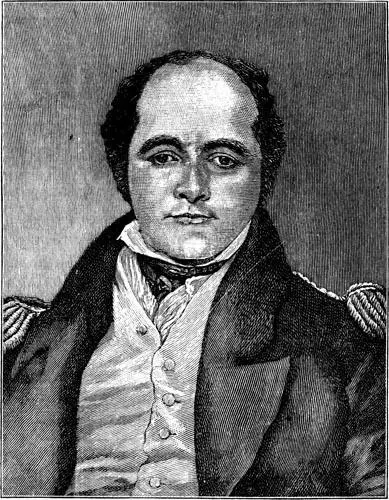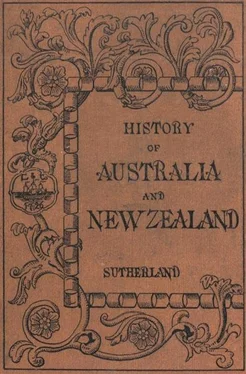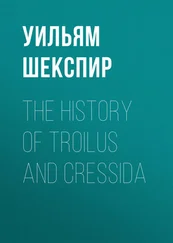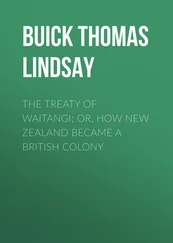8. Giles and Forrest.—Towards the close of the same year, 1873, a young Victorian named Giles started on a similar trip, intending to cross from the middle of the telegraph line to West Australia. He held his course courageously to the west, but the country was of such appalling barrenness that, after penetrating half-way to the western coast, he was forced to abandon the attempt and return. But when three years afterwards he renewed his efforts, he succeeded, after suffering much and making long marches without water. He had more than one encounter with the natives, but he had the satisfaction of crossing from the telegraph line to the West Australian coast, through country never before traversed by the foot of civilised man. In 1874 this region was successfully crossed by Forrest, a Government surveyor of West Australia, who started from Geraldton, to the south of Shark Bay, and, after a journey of twelve hundred miles almost due east, succeeded in reaching the telegraph line. His entry into Adelaide was like a triumphal march, so great were the crowds that went out to escort him to the city. Forrest was then a young man, but a most skilful and sagacious traveller. Lightly equipped, and accompanied by only one or two companions, he has on several occasions performed long journeys through the most formidable country with a celerity and success that are indeed surprising.
His brother, Alexander Forrest, and a long list of bold and skilful bushmen, have succeeded in traversing the continent in every direction. It is not all desert. They have found fine tracts of land in the course of their journeys. Indeed, more than half of the recently explored regions are suitable for sheep and cattle, but there are other great districts which are miserable and forbidding. However, thanks to the heroic men whose names have been mentioned, and to such others as the Jardine Brothers, Ernest Favenc, Gosse, and the Baron von Mueller, almost the whole of Australia is now explored. Only a small part of South Australia and the central part of West Australia remain unknown. We all of us owe a great debt of gratitude to the men who endured so much to make known to the world the capabilities of our continent.
CHAPTER XIX.
TASMANIA, 1837-1890.
1. Governor Franklin.—Sir John Franklin, the great Arctic explorer, arrived in 1837 to assume the Governorship of Tasmania. He had been a midshipman, under Flinders, during the survey of the Australian coasts, and for many years had been engaged in the British Navy in the cause of science. He now expected to enjoy, as Governor of a small colony, that ease and retirement which he had so laboriously earned. But his hopes were doomed to disappointment. Although his bluff and hearty manner secured to him the good-will of the people, yet censures on his administration were both frequent and severe; for during his rule commenced that astonishing decline of the colony which continued, with scarcely any interruption, for nearly thirty years.

Sir John Franklin.
2. Flood of Convicts.—After the cessation of transportation to New South Wales, in 1840, hopes were entertained that Tasmania would likewise cease to be a penal settlement; and, under this impression, great numbers of immigrants arrived in the colony. But, ere long, it became known that Tasmania was not only to continue, as before, a receptacle for British felons, but was, in fact, to be made the only convict settlement, and was destined to receive the full stream of criminals, that had formerly been distributed over several colonies. The result was immediately disastrous to the free settlers, for convict labour could be obtained at very little cost, and wages therefore fell to a rate so miserable that free labourers, not being able to earn enough for the support of their families, were forced to leave the island. Thus, in 1844, whilst the arrival of energetic and hard-working immigrants was adding greatly to the prosperity of the other colonies, Tasmania was losing its free population, and was sinking more and more into the degraded position of a mere convict station.
Lord Stanley, the British Colonial Secretary, in 1842, proposed a new plan for the treatment of convicts, according to which they were to pass through various stages, from a condition of absolute confinement to one of comparative freedom; and, again, instead of being all collected into one town, it was arranged that they should be scattered throughout the colony in small gangs. By this system it was intended that the prisoners should pass through several periods of probation before they were set at liberty; and it was, therefore, called the Probation Scheme. The great objection to it was that the men could scarcely be superintended with due precaution when they were scattered in so many separate groups, and many of them escaped, either to the bush or to the adjacent colonies.
3. Franklin’s Difficulties.—The feelings of personal respect with which the people of Van Diemen’s Land regarded Sir John Franklin were greatly increased by the amiable and high-spirited character of his wife. Lady Franklin possessed, in her own right, a large private fortune, which she employed in the most generous and kindly manner; her counsel and her wealth were ever ready to promote prosperity and alleviate sufferings. And yet, in spite of all this personal esteem, the experience of the new Governor among the colonists was far from being agreeable.
Before the arrival of Sir John Franklin, two nephews of Governor Arthur had been raised to very high positions. One of them, Mr. Montagu, was the Chief Secretary. During his uncle’s government he had contrived to appropriate to himself so great a share of power that Franklin, on assuming office, was forced to occupy quite a secondary position. By some of the colonists the Governor was blamed for permitting the arbitrary acts of the Chief Secretary; while, on the other hand, he was bitterly denounced as an intermeddler by the numerous friends of the ambitious Montagu, who, himself, lost no opportunity of bringing the Governor’s authority into contempt. At length Montagu went so far as to write him a letter containing—amid biting-sarcasm and mock courtesy—a statement equivalent to a charge of falsehood. In consequence of this he was dismissed; but Sir John Franklin, who considered Montagu to be a man of ability, magnanimously gave him a letter to Lord Stanley, recommending him for employment in some other important position. This letter, being conveyed to Lord Stanley, was adduced by Montagu as a confession from the Governor of the superior ability and special fitness of the Chief Secretary for his post. Lord Stanley ordered his salary to be paid from the date of his dismissal; and Franklin, shortly after this insult to his authority, suddenly found himself superseded by Sir Eardley Wilmot, without having received the previous notice which, as a matter of courtesy, he might have expected. In 1843 he returned to England, followed by the regrets of nearly all the Tasmanians.
Two years afterwards he sailed with the ships Erebus and Terror to search for a passage into the Pacific Ocean through the Arctic regions of North America. He entered the ice-bound regions of the north, and for many years no intelligence regarding his fate could be obtained. Lady Franklin prosecuted the search with a wife’s devotion, long after others had given up hope; and, at last, the discovery of some papers and ruined huts proved that the whole party had perished in those frozen wastes.
4. Governor Wilmot.—Sir Eardley Wilmot had gained distinction as a debater in the British Parliament. Like Governors Bligh and Gipps, in New South Wales, Wilmot found that to govern at the same time a convict population and a colony of free settlers was a most ungrateful task. A large proportion of the convicts, after being liberated, renewed their former courses: police had to be employed to watch them, judges and courts appointed to try them, gaols built to receive them, and provisions supplied to maintain them. If a prisoner was arrested and again convicted for a crime committed in Tasmania, then the colony was obliged to bear all the expense of supporting him, and amid so large a population of criminals these expenses became intolerably burdensome. It is true that colonists had to some extent a compensating advantage in receiving, free of charge, a plentiful supply of convict labour for their public works. But when Lord Stanley ordered that they should in future pay for all such labour received, they loudly complained of their grievances. “Was it not enough,” they asked, “to send out the felons of Great Britain to become Tasmanian bushrangers, without forcing the free settlers to feed and clothe them throughout their lives, after the completion of their original sentences?” To all such remonstrances Lord Stanley’s answer was that Tasmania had always been a convict colony; and that the free settlers had no right to expect that their interests would be specially consulted in the management of its affairs. Sir Eardley Wilmot found it impossible to obtain the large sums required for the maintenance of the necessary police and gaols, and he proposed to the Legislative Council to borrow money for this purpose. Those of the Council who were Government officials were afraid to vote in opposition to the wishes of the Governor, who, therefore, had a majority at his command. But the other members, six in number, denounced the proposed scheme as injurious to the colony; and when they found that the Governor was determined to carry it out, they all resigned their seats. For this action they were honoured with the title of the “Patriotic Six”.
Читать дальше













